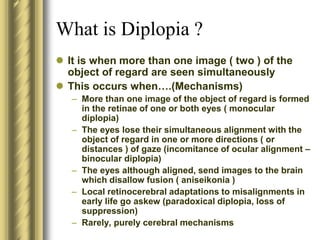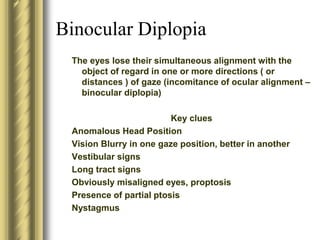32-Approach-to-a-patient-with-diplopia-battu.ppt
- 1. Approach to a patient with diplopia Dr. R.R.Battu Narayana Nethralaya
- 2. What does the faculty of BSV require? ŌĆō Perfect ( or near perfect ) alignment of the visual axes simultaneously on the object of regard ŌĆō Perfect ( or near perfect ) retinal correspondence ŌĆō Perfect central ( or paracentral ) fusional capability. ŌĆō Perfect ( or near perfect ) alignment of the retinal receptors ŌĆō Perfect ( or near perfect ) optics to allow only one image to be formed on the retina and the same single image to be formed on the other
- 3. What is Diplopia ? ’ü¼ It is when more than one image ( two ) of the object of regard are seen simultaneously ’ü¼ This occurs whenŌĆ”.(Mechanisms) ŌĆō More than one image of the object of regard is formed in the retinae of one or both eyes ( monocular diplopia) ŌĆō The eyes lose their simultaneous alignment with the object of regard in one or more directions ( or distances ) of gaze (incomitance of ocular alignment ŌĆō binocular diplopia) ŌĆō The eyes although aligned, send images to the brain which disallow fusion ( aniseikonia ) ŌĆō Local retinocerebral adaptations to misalignments in early life go askew (paradoxical diplopia, loss of suppression) ŌĆō Rarely, purely cerebral mechanisms
- 4. Monocular vs Binocular Diplopia Key question Is the double vision present even on monocular eye closure?
- 5. Monocular diplopia ’ü¼ More than one image of the object of regard is formed in the retinae of one or both eyesŌĆ”.. ŌĆō Irregular astigmatism ( nebular scars, haze, corneal distortion) ŌĆō Subluxated clear lenses ŌĆō Poorly fitting contact lenses ŌĆō Early cataract ŌĆō Iridodialysis, polycoria, large iridotomies ŌĆō Macular disorders ŌĆō edema, CNVM etc
- 6. Binocular Diplopia The eyes lose their simultaneous alignment with the object of regard in one or more directions ( or distances ) of gaze (incomitance of ocular alignment ŌĆō binocular diplopia) Key clues Anomalous Head Position Vision Blurry in one gaze position, better in another Vestibular signs Long tract signs Obviously misaligned eyes, proptosis Presence of partial ptosis Nystagmus
- 7. Questions to be asked ’ü¼Is there a mis alignment? ’ü¼If so, in which directions ( or distances ) of gaze? ’ü¼Which are the hypofunctioning ( and hyperfunctioning ) muscles? ’ü¼Do they have a neurogenic pattern, or a restrictive pattern or a neuromuscular pattern or a myogenic pattern?
- 8. Identifying muscle/s involved ’ü¼AHP ŌĆō Predominant face turn ŌĆō horizontal recti ŌĆō Predominant chin elev/dep ŌĆō vertical recti, pattern strabismus ŌĆō Predominant tilt ŌĆō Obliques
- 9. Diplopia - Key questions Is the diplopia more for distance or near? Is the diplopia predominantly horizontal or vertical? In which direction of gaze are the images maximally separated? To which eye does the ŌĆ£outerŌĆØ image belong? Is there a predominant tilt? In which position of gaze does the tilt increase maximally?
- 10. Diplopia charting ’ü¼Diplopia is maximum ( separation of images) in the field of action of the paralysed muscle. ’ü¼The false image ( the image belonging to the eye with the hypofunctioning muscle ) is always peripherally situated ŌĆō Higher in upgaze, lower in downgaze, on the right in right gaze and on the left in left gaze
- 11. Hess Charting ’ü¼Based on the principle of confusion ’ü¼Allows for identifying the position of one eye, while the other eye fixes in different positions of gaze. ’ü¼Effectively demonstrates SherringtonŌĆÖs and HeringŌĆÖs laws ’ü¼Allows for more objective follow up also.
- 12. The cover-uncover and alternate cover tests ’ü¼Probably the most important objective tests to evaluate muscle palsies ’ü¼Measurements with a prism bar allow for measurement ’ü¼Measure in the 9 cardinal gaze positions ’ü¼Distance and near
- 13. Versions & Ductions ’ü¼Allow to assess actual rotation limits ’ü¼Allow assessment of underactions and overactions of synergists
- 14. Saccadic Velocity ’ü¼ŌĆ£Floating saccadesŌĆØ are suggestive of a nerve palsy or paresis ’ü¼Indirectly ŌĆ£oblique saccadeŌĆØ testing can be done. ’ü¼Normal saccadic velocity with limitation indicates a restricted muscle
- 15. Forced Duction Testing ’ü¼Allows to assess forced movement in direction of restriction ŌĆō Important in Blow out fractures, TED, long standing strabismus with contractures ’ü¼Important to lift the globe and rotate
- 16. Force Generation Testing ’ü¼Allows to identify residual power in a suspected paretic muscle. Usually done to direct management ŌĆō 6th N palsy ŌĆó Recess ŌĆō resect or muscle transposition
- 17. Pointers to primary orbital disease ’ü¼Restrictive muscle hypofunction ’ü¼Proptosis ’ü¼Signs of orbital inflammation ’ü¼Signs of anterior segment, lid and adnexal hyperemia or inflammation
- 18. ’ü¼ Look for supranuclear, nuclear and infranuclear patterns ’ü¼ Look for sensory ( visual ) abnormalities ’ü¼ Look for nystagmus ’ü¼ Look for vestibular ŌĆō auditory symptoms ’ü¼ Look for other cranial nerve involvement ’ü¼ Look for long tract signs Neurological disease
- 19. CNS and orbital imaging ’ü¼Done for obvious neurological patterns ’ü¼Orbital inflammatory disease, proptosis ’ü¼Occasionally may avoid or delay ŌĆō Pupil sparing 3rd in a diabetic ŌĆō 6th Nerve in a hypertensive, image if no spontaneous recovery in a few weeks
- 20. Imaging ’ü¼CT ’ü¼MRI ŌĆō Fat suppression ŌĆō Stir sequences ’ü¼MRA vs CT angio
- 21. Ancillary tests ’ü¼Tests for myasthenia ’ü¼Tests of thyroid function ’ü¼X- ray chest ’ü¼Bloods
- 22. Aniseikonia ’ü¼Occurs when image size disparity exceeds 5% ’ü¼Previously seen in monocular aphakia ’ü¼May occur following keratorefractive surgery
- 23. ’ü¼Classically for near ’ü¼Could be primary or secondary Convergence insufficiency
- 24. Others ’ü¼Suppression scotomas ’ü¼Decompensated squints with Anomalous Retinal Correspondence ’ü¼Paradoxical diplopia























